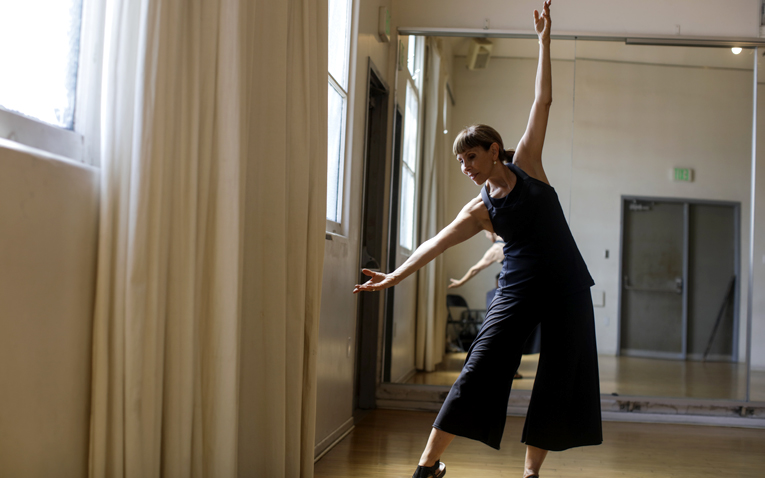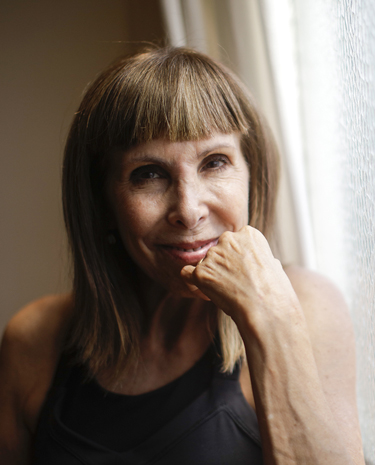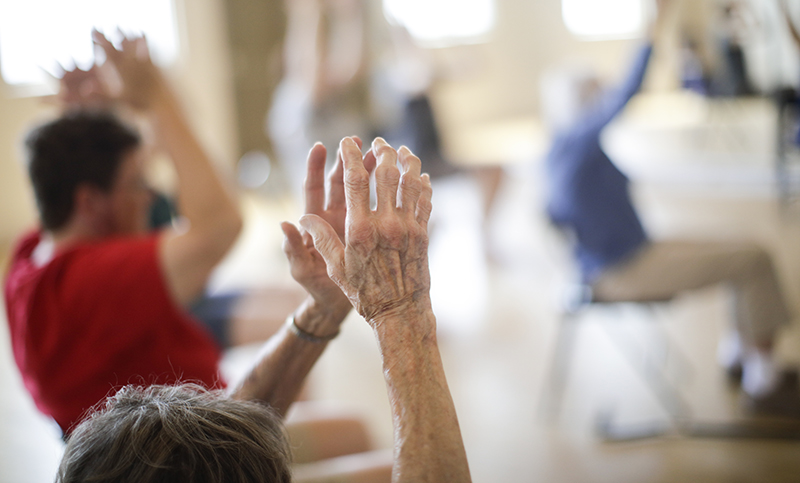Cedars-Sinai Blog
Dancing Through Parkinson's
Jul 11, 2017 Cedars-Sinai Staff

Linda Berghoff believes the best prescription for Parkinson's disease is dancing.
After being diagnosed in 2006, Linda decided to teach herself and others how to work with the disease and move past it.
At least 3 times a week, in studios throughout Southern California, Linda teaches Dancing Through Parkinson's. The class encourages strength, mental clarity, stability, joy, creativity, and above all, community for people with or without the disease.
"We are all dancers."

Linda Berghoff
"This disease can be very isolating, especially if your symptoms are worse, and I get it," says the 66-year-old. "But after an hour of dancing and thinking about other things, you walk out feeling different. Everybody says that. You feel better, and you walk out stronger because you're doing something to help yourself."
Although dancing isn't an official remedy for Parkinson's disease, Linda's neurologist Dr. Michele Tagliati encourages the practice, saying it promotes healthy living while exercising skills that can be compromised as a result of the degenerative disease like concentration, balance, turning, and speaking.
"What we do see, and it is shown with patients like Linda who have a slow progressing form of Parkinson's, is that she's able to take up dance and benefit from it for a long time," says Dr. Tagliati, who is the director of Cedars-Sinai's Movement Disorders Program in the Department of Neurology.
"While others are free to choose different passions, Linda has chosen a particular mission of dance therapy. Not only that, she has devoted most of her personal time to developing this alterative style of treatment to help others in this community. In many ways she is a true pioneer."
Recognizing the symptoms
Parkinson's disease usually occurs relatively late in life, and progresses slowly over time. In 5-10% of cases, the disease may develop in those younger than 50. Signs and symptoms of Parkinson's include slow movement, tremors, stiff or rigid muscles, changes in speech, and difficulty with balance and posture. Patients can also experience trouble sleeping, constipation, unstable blood pressure, depression, and loss of smell.
"I'm independent and the thing with Parkinson's is most people lose that, and I didn't want to be dependent on anyone."
Linda ignored some signs of the disease, using the excuse of clumsiness when she repeatedly tripped and aging when her body resisted certain dance moves. Then, while on vacation in New York, her left leg wouldn't stop shaking. This was the red flag she couldn't ignore. While there, she saw a neurologist who diagnosed her with the disease.
Linda's family history of Parkinson's raised an immediate sense of fear.
"I thought it was a dirty trick because I had always taken care of myself, " she says. "I'm independent and the thing with Parkinson's is most people lose that, and I didn't want to be dependent on anyone."
When Dr. Tagliati joined Cedars-Sinai in 2010, Linda immediately sought his expertise and became one of his first patients. Dr. Tagliati monitored her symptoms and gradually put her on small doses of medication to help manage the tremors and help Linda feel like herself again.
"The way you manage the disease in the beginning in many ways helps prevent long-term complications," says Dr. Tagliati, who is one of the nation's leading research and treatment specialists in Parkinson's disease and other movement disorders. "This is why it is very important to see a specialist from day one."
For Linda, having a neurologist who is well versed in the disease put her body and mind at ease. "Everyone with Parkinson's disease is scared because you don't want to lose yourself," Linda says. "With Dr. Tagliati, he gets it, he's compassionate, and he's sharp. He makes everything about you."

Michele Tagliati, MD
Sharing rhythm and joy
Linda started dancing when she was 10 and continued into her teens and through college. When she had children she pressed the pause button on the pastime, but resumed later in life adding Pilates and daily recreational dance classes.
After Linda's diagnosis, neighbor and friend Laura Karlin, artistic director of Invertigo Dance Theater in Los Angeles, reached out to see what she could do to help.
"The way you manage the disease in the beginning in many ways helps prevent long-term complications," says Dr. Tagliati.
Linda remembered seeing a dance program for patients with Parkinson's while in New York and knew immediately she wanted to do the same back home. With the help of Laura and the theater, the program became possible. Today, Linda leads classes with up to 20 people throughout Los Angeles. Some attendees have the disease, while others come to stay active or meet new people.
"Even though I'm not a professional dancer, I know what others are going through, like when they can't do something or when balancing is tough," says Linda. "I understand the way the body works as a dancer, and having Parkinson's myself, I understand and appreciate the challenges I and others have. And my dance background helps me develop strategies to move with Parkinson's."
"Everyone has rhythm and joy inside of them—you just have to open your arms to that."
At a recent Dancing Through Parkinson's class at the Electric Lodge Performing Dance Center in Venice, Linda had dancers stomping their feet, snapping their fingers, humming, stretching, and participating in games where they would act out a verb through body movements.
One activity had dancers perform a choreographed dance routine from the musical "West Side Story." The dancers were separated into two groups at opposite ends of the studio and slowly moved their bodies to the rhythm, until they met in the middle.
With every turn of the wrist, sound and kick, the group exercised brains, bodies, and memory. Personalities started to shine, and for a while, some forgot about their ailments.
"The trick is to make people believe we are all dancers," Linda says, laughing. "People who come the first time always say, 'I'm going to watch. I can't dance.' But I believe everyone has rhythm and joy inside of them—you just have to open your arms to that."

Berghoff's doctor promotes her dancing as a healthy activity that exercises skills that can be compromised as a result of Parkinson's disease.


